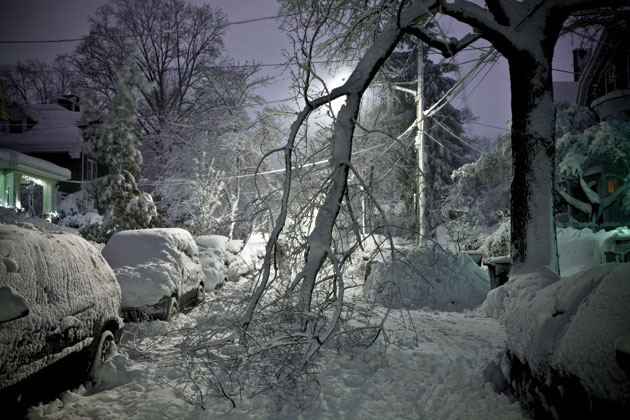
The 2010 blizzard that halted holiday travel throughout the Northeast caused widespread disruption and great economic loss. In addition to the direct costs, the retail sector reportedly lost up to $1 billion and airlines suffered another $150 million in lost revenue. While these figures are staggering and the storm inconvenienced millions, the fallout was mild compared to the nation's worst whiteouts. Here is a look back at some of the most abominable snowstorms to ever hit the United States.
The Great White Hurricane
March 11-14, 1888
The earliest entry on the list may have been the worst. Snowfall of 40 to 50 inches was recorded throughout New Jersey, New York, Massachusetts and Connecticut. The winds were so great that snowdrifts reached 50 feet high and more than 400 died. Most every city on the entire Eastern Seaboard from Virginia to Maine was paralyzed for days-and in some cases weeks. Widespread flooding and fires followed, while conditions were made even worse by the fact that few firehouses were operational and able to extinguish the raging blazes.
The Great Blizzard of 1899
February 11-14, 1899
This monumental storm set records that have yet to be broken more than 120 years later and is best known for the bone-chilling temperatures it brought across nearly the entire United States. Beginning in the Southeast, the storm dumped "ocean-effect" snow on Tampa Bay before heading west and freezing over New Orleans to the point that ice floes were drifting from the Mississippi River into the Gulf of Mexico. Monterey, Virginia, reached a still-record-low temperature of -29?F and Cape May, New Jersey, received a still-record 34 inches of snow.
The Great Lakes Storm
November 7-10, 1913
The deadliest natural disaster to hit the Great Lakes region was exacerbated by the fact that it was not predicted by forecasters. As a result, the up-to-35-foot swells it generated sank at least 19 sailing ships, killing at least 260 people. Another reason so many sailors were left stranded and shivering was the storm's duration. A typical blizzard will pass through the area in about five hours. This one stuck around for 16.
The Knickerbocker Storm
January 27-28, 1922
The weight of the snowfall from this blizzard caused the largest movie house in Washington, D.C., the Knickerbocker Theatre, to collapse. More than 600 rescue workers gathered to sift through the wreckage but were unable to save the 98 people who died in the disaster. Another 133 were injured among them Congressman Andrew Jackson Barchfield. Both the theater's architect, who was officially cleared of any blame in the tragedy, and its owner committed suicide within 15 years of the collapse.
The Great Appalachian Storm
November 24-30, 1950
Snow, wind and rain killed 353 people over the course of a week throughout the Eastern United States and left more than a million without power. Total economic losses reached $66.7 million (in 1950 dollars) and insurance companies wound up footing the bill, paying out more for this event than they ever had for any storm.
The Super Bowl Blizzard
January 9-12, 1975
The 28.62 barometric pressure recorded during this blizzard would stand as a record until 1998, as stranded Midwesterners were forced to watch the NFL's Minnesota Vikings lose their second consecutive Super Bowl amid 20-foot drifts. Worse still, the storm triggered 45 tornadoes throughout the Midwest that, together with the snow and wind, killed 70 people.
The Storm of the Century
March 11-15, 1993
An immense, cyclonic storm killed more than 300 and at one point stretched from Canada to Central America. The blizzard blanketed parts of the Northeast with up to 42 inches of snow and brought storm surges of 12 feet. Meanwhile, Alabama was hit with six inches of snow and much of the South was inundated with nearly a foot-and-a-half of rain amid tornadoes and thunderstorms.
